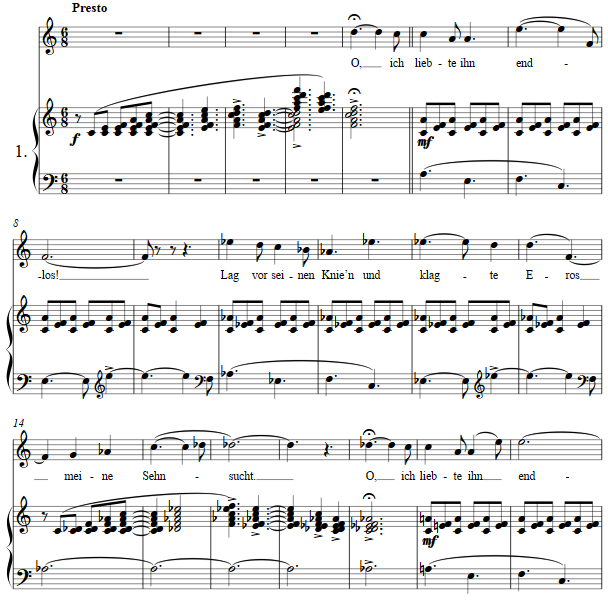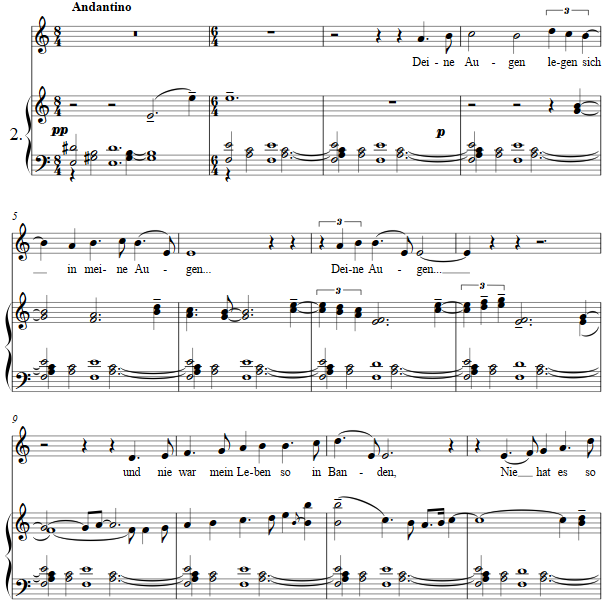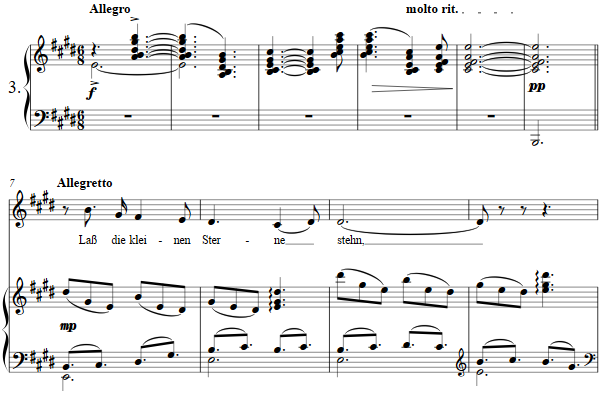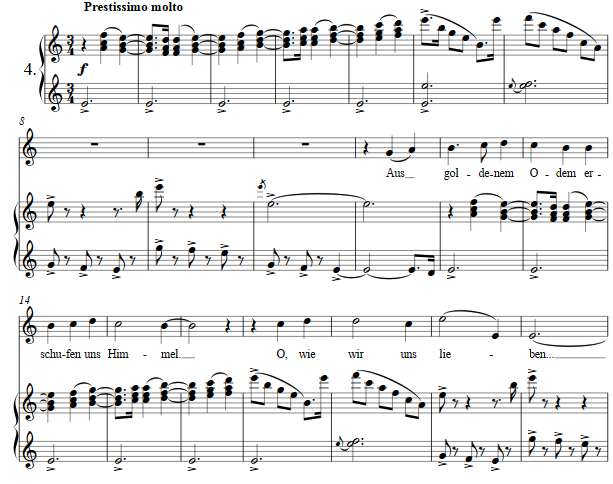Music and Texts of GARY BACHLUND
Vocal Music | Piano | Organ | Chamber Music | Orchestral | Articles and Commentary | Poems and Stories | Miscellany | FAQs
Elses Liebeslieder - (2018)
Else Lasker-Schüler
for mezzo soprano and piano
Petra & Ralph-Robert Lichterfeld gewidmet
i. - Eros
O, ich liebte ihn endlos!
Lag vor seinen Knie’n
Und klagte Eros
Meine Sehnsucht.
O, ich liebte ihn fassungslos.
Wie eine Sommernacht
Sank mein Kopf
Blutschwarz auf seinen Schoss
Und meine Arme umloderten ihn.
Nie schürte sich so mein Blut zu Bränden,
Gab mein Leben hin seinen Händen,
Und erhob mich aus schwerem Dämmerweh.
Und alle Sonnen sangen Feuerlieder
Und meine Glieder
Glichen
Irrgewordenen Lilien.
ii. - Melodie
Deine Augen legen sich in meine Augen
Und nie war mein Leben so in Banden,
Nie hat es so tief in Dir gestanden
Es so wehrlos tief.
Und unter Deinen schattigen Träumen
Trinkt mein Anemonenherz den Wind zur Nachtzeit,
Und ich wandle blühend durch die Gärten
Deiner stillen Einsamkeit.
iii. - Unser Liebeslied
Laß die kleinen Sterne stehn,
Lenzseits winken junge Matten
Meiner Welten, die nichts wissen vom Geschehn.
Und wir wollen unter Pinien
Heimlich beide umschlungen gehn,
In die blaue Allmacht sehn.
Zwischen Garben
Und Schilfrohrruten
Steigen Schlummer auf aus Farben.
Und von roten Abendlinien
Blicken Marmorwolkenfresken
Und verzückte Arabesken.
iv. - Ein Liebeslied
Aus goldenem Odem
Erschufen uns Himmel.
O, wie wir uns lieben ...
Vögel werden Knospen an den Ästen,
Und Rosen flattern auf.
Immer suche ich nach deinen Lippen
Hinter tausend Küssen.
Eine Nacht aus Gold,
Sterne aus Nacht ...
Niemand sieht uns.
Kommt das Licht mit dem Grün,
Schlummern wir;
Nur unsere Schultern spielen noch wie Falter.14 pages, circa 9' 00"
Else Lasker-Schüler (1869-1945)
Lasker-Schüler, who poet Gottfried Benn stated was in that time "Germany’s greatest lyric poet," fled Berlin, emigrated to Switzerland in 1933 after the National Socialists came into government, and in 1940 she emigrated to Jerusalem, in that time called Palestine, as Israel as a nation had not been founded. In Berlin at the beginning of the 20th century, she was a part of the avant garde literary circle, and was associated with the Expressionist journal, Der Sturm. In that time before she fled Germany, she moved among writers and poets who published in that journal, as well as graphic artists whose works were displayed at a gallery associated with Der Sturm, and included legendary names as we think of them today. The gallery closed in 1924, and the journal ceased publication in 1933, as many creative artists fled.
One reads: "By the time Else Lasker-Schüler left Germany, in 1933, she was 64 years old and had the bulk of her work behind her. It is both sad and ironic, that even after she left, her tires to Germany remained strong. "Immer denke ich an Deutschland, das ich so liebe," she wrote to a friend from Switzerland. In her entire adult life, she never wrote in any language but German (unless you count the make-believe language she called 'mystical asiatic' into which she translated a few of her own poems, as for example 'Wakan liachad abtal,' which sounds suspiciously like mock Hebrew. ...In her lifetime, only two volumes of her work were published outside of Germany, the prose volume, Das Hebräerland, a series of impressions loosely based on her first trip to Palestine, appeared in Switzerland in 1937, and her last group of poems, Mein blaues Klavier, was published in Palestine in 1943. This volume bears, what was, at that time, a bizarre, if not shocking, dedication, coming from a German-Jewish refugee living in Palestine, "Meinen unvergesslichen Freunden und Freundinnen in den Städten Deutschlands und denen, die wie ich vertrieben und nun zerstreut in der Welt, in Treue!" In "Else Lasker-Schüler: a German-Jewish poet in exile," by Evelyn Torton Beck, University of Wisconsin, 1971.
These settings were composed in Berlin, which I still take to be Lasker-Schüler's Berlin, a place of continuing creativity and even salvation in spite of its few years fallen to the evils of National Socialism, and thereafter for a time, Soviet Socialism.
For mezzo soprano (or alto) the first setting in rushes forward in 6/8 as the voice opens, declaring "Oh, I loved him endlessly! Laid before his knees and pled to Eros of my longing," as tonal areas shift energetically. The seventh serves in melodic and harmonic importance, as the final cadence and segue to the second setting relate.
The second setting breaks the intial mood of the cycle, with its static harmony underpinning the melody above. Reference to the tonal areas of the opening song explain the second strophe's harmonic shift.
The third adopts the final cadence of the second, now clearly in a secondary major to the overall cycle. This more lyrical 6/8 echoes the first in a more relaxed tempo and mood, as the text tells, "Let the little stars stand, as springtime beckons with beds for youth...." .
The fourth races with enthusiasm, as the voice rhapsodizes, "Of golden breath heaven made us. Oh, how we love each other ..." The simple form, ABAB, allows form to mirror the notation of the text.
For other settings of Lasker-Schüler texts, click here.
The score is available as a free PDF download, though any major commercial performance or recording of the work is prohibited without prior arrangement with the composer. Click on the graphic below for this art song score.




